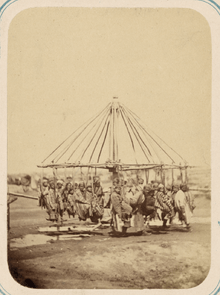Navruz in Uzbekistan
Navruz (Uzbek: Navroʻz / Наврўз) is celebrated widely in Uzbekistan. It is the day of the vernal equinox, and marks the beginning of spring in the Northern Hemisphere. It has been celebrated on the territory corresponding to modern-day Uzbekistan for at least two thousand years.[1]

When Uzbekistan was part of the Soviet Union, celebrations of Navruz were generally unofficial, and at times even prohibited.[2] Currently Navruz is an official public holiday in Uzbekistan and is always celebrated on March 21. Still, holiday celebrations are spread out over several days.
Navruz customs
In preparation for the holiday, people tidy their homes and mahallas (neighborhoods), and buy new clothes. Before, during, and after Navruz, it is customary to prepare sumalak, the main ceremonial dish of the holiday. Sumalak is a sweet paste made entirely from germinated wheat and is cooked in a large kazan. To prepare sumalak friends, relatives, and neighbors – usually women – gather around the kazan, all taking a turn to stir the mixture. When ready, sumalak is distributed among neighbors, relatives, and friends. At Navruz, people also visit relatives and friends and give presents to children.
Navruz is often cited as the most popular holiday in Uzbekistan.[1] On March 21, elaborate holiday concerts are organized across the country, notably in the capital city of Tashkent. Book fairs, concerts, games, and special televisision and radio programs last for the whole month of March. It has been noted that after Uzbekistan gained independence in 1991, government officials have promoted Navruz as a main national holiday and have tightly controlled the content and form of the festivities.[2]
References
- Sahadeo, Jeff; Zanca, Russell, eds. (2007). Everyday Life in Central Asia: Past and Present. Bloomington: Indiana University Press. pp. 202–203. ISBN 9780253013538.
- Tursunova, Zulfiya (2014). Women’s Lives and Livelihoods in Post-Soviet Uzbekistan: Ceremonies of Empowerment and Peacebuilding. London: Lexington Books. pp. 26–27. ISBN 9780739179789.